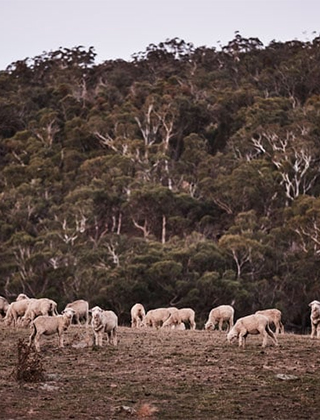Rabbits

European rabbits are Australia’s most widespread and destructive environmental and agricultural vertebrate pest.
European rabbits are Australia’s most widespread and destructive environmental and agricultural vertebrate pest.
Rabbit grazing can prevent seedlings from regenerating and reduce crop yields, as well as increase competition for feed with livestock. Rabbits damage native plants and directly compete with native wildlife for food and shelter. Their digging and browsing leads to a loss of vegetation cover, which in turn can result in slope instability and soil erosion.
There are at least 304 Australian threatened species that may be adversely affected by competition and land degradation by rabbits.
Rabbits cost the Australian wool industry $31.54 million each year. From the initial control methods of the 1950s through to the introduction of Rabbit Haemorrhagic Disease (RHD) in the mid-1990s, the control of rabbits has been a significant, industry-wide issue.
An introduction to the rabbit problem in Australia
This video provides a general introduction to the rabbit problem in Australia so that woolgrowers can get the best result from the release of RHDV1 K5. This video is part of the Rabbit Control Video Series 2017 prepared with funding from AWI.
Integrated control methods
While biological control is very effective at reducing rabbit numbers, biological control alone is not enough. It is important to apply and integrate a number of control methods. In most situations, no single method will provide adequate control of rabbits in the long term.
The first step is to reduce the rabbit population from medium–high densities down to a manageable level. This is usually done by biological control (via natural outbreak or deliberate release) and/or chemical control (for example a poison baiting program) during the non-breeding season.
If RHD or myxomatosis are already present, then poison baiting should be delayed to allow the disease to reduce rabbit numbers. If rabbit density is low then extensive control can be started straight away.
Conventional control
The next part of the control program should destroy all source areas (where rabbits are living) and reduce rabbits to very low numbers. Control activities include warren ripping and destruction/removal of harbours which provide rabbits with shelter, such as fallen logs, building debris or dense vegetation. Where the use of heavy machinery is not an option for warren ripping, alternative techniques such as explosives and fumigation may be used.
Extensive control ensures that the rabbit population cannot recover quickly but it must be done thoroughly to ensure success. If any warrens or harbour are not destroyed, rabbit numbers will simply build up again. Sometimes rabbits can also dig back in and ‘re-open’ warrens if ripping is not done thoroughly (deep or wide enough) and the collapse of the warren structure is inadequate.
There are usually small numbers of rabbits that survive extensive control, so advanced control is necessary for long-term management. This is where follow-up techniques such as fumigation, shooting and trapping are used in rabbit-active areas.
RabbitScan can be used within your local area to map rabbit problem areas, and to help coordinate control after RHDV1 K5 to maximise the long-term benefits of the virus release.
The popular RabbitScan app, developed through the Invasive Animals CRC, tracks the spread of rabbit biocontrol agents and viruses from a smart phone or computer, via a digital map. RabbitScan is available free at www.rabbitscan.org.au.
Farmers, land managers and the community can play an important role in recording evidence of rabbit disease which can be used to guide local rabbit management activities.
The App takes you through a few simple steps to record details of dead rabbits and includes images of rabbits affected by virus and disease for easy identification.
A powerful aspect of the new tracker gives people the opportunity to submit tissue samples from dead rabbits with suspected RHD virus. When users click to submit a tissue sample our research team sends a free, postage-paid sampling kit with full instructions on how to collect and send the sample.
Once the tissue sample is analysed an update on the digital map will record the results, and the person who submitted the sample will be notified with accurate information of what virus is affecting rabbits in their area or control site, which is valuable information for their local rabbit management plan.
RabbitScan
In an effort to significantly reduce pest rabbit populations and their negative impact on agricultural production and native ecosystems, the new virus known as RHDV1 K5 was released at more than 600 sites across Australia in March 2017.
Community organisations, Landcare groups and government land managers are participating in the national roll-out of the virus, as part of the RHD Boost project funded through the Invasive Animals CRC with additional funding from AWI.
The sites were selected strategically in consultation with rabbit experts from each state. Priority was given to sites well known to be rabbit prone, were not within 50km of the nationally coordinated intensive monitoring sites and were placed to ensure maximum coverage of areas where rabbits are distributed. Monitoring sites were selected from various rabbit affected locations around Australia to examine RHDV1 K5 effectiveness in various habitats and climates.
Preparing for the release of RHDV1 K5
Further Information
Rabbit control research and practical rabbit control and monitoring tools:
- IACRC Outcome 3 (Rabbits) - the suite of IACRC rabbit control investments, including the seven AWI projects, and others monitoring the release of the new RHD vaccine, developing of a resistance model, a rabbit decision support tool and a National Facilitator for rabbit control advice.
- AWI R&D update - rabbit control (PDF 70Kb).
- PestSmart Rabbit Toolkit - best practice rabbit control fact sheets, case-studies, technical manuals and scientific reports.
- RabbitScan - record rabbit sightings in this free web based mapping tool.
- Rabbits: A threat to conservation & natural resource management (PDF 1.27 MB) - A booklet that outlines a quick method to help producers assess the impact of rabbits and take action on their properties.















